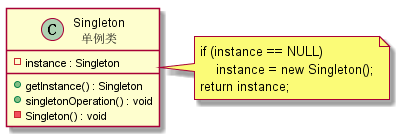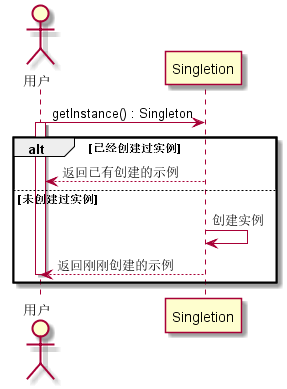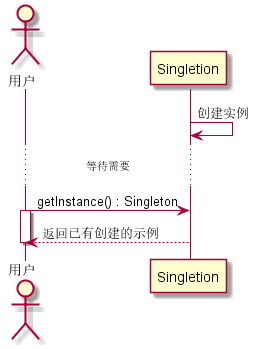单例模式(Singleton Pattern): 单例模式确保某一个类只有一个实例, 而且自行实例化并向整个系统提供这个实例, 这个类称为单例类, 它提供全局访问的方法.
设计模式-概述
很多情况只需要一个对象就可以满足要求, 例如Factory类型的对象, 使用单例模式能让系统避免创建大量对象, 减少资源占用开销.
结构
单例模式仅有一个角色 : Singleton, 并且私有化其构造器, 提供一个方法返回实例, 实例的创建时机由本类控制.

1
2
3
4
5
6
7
8
9
10
11
12
13
14
15
16
17
18
19
| @startuml sigleton-1
!include ./common.cuml
Class(Singleton,"单例类") {
- instance : Singleton
+ getInstance() : Singleton
+ singletonOperation() : void
- Singleton() : void
}
note AS A
if (instance == NULL)
instance = new Singleton();
return instance;
end note
A .left. Singleton
@enduml
|
使用时序
可以分为两种情况
使用时再创建

1
2
3
4
5
6
7
8
9
10
11
12
13
14
15
16
17
| @startuml sigleton-2
actor 用户 as U
participant Singletion as S
U -> S : getInstance() : Singleton
activate U
alt 已经创建过实例
U <-- S : 返回已有创建的示例
else 未创建过实例
S -> S : 创建实例
U <-- S : 返回刚刚创建的示例
deactivate U
end
@enduml
|
预先创建

1
2
3
4
5
6
7
8
9
10
11
12
13
| @startuml sigleton-3
actor 用户 as U
participant Singletion as S
S -> S : 创建实例
... 等待需要 ...
U -> S : getInstance() : Singleton
activate U
U <-- S : 返回已有创建的示例
deactivate U
@enduml
|
代码实现
大家经常把”使用时再创建对象”称为 懒汉式, “预先创建对象”称为饿汉式.
懒汉式
懒汉式由于是使用时再创建, 如果多线程环境, 多个地方同时调用 getInstance(), 则很可能出现并发问题, 导致创建了多个对象, 所以要对其特殊处理, 防止出现并发问题.
使用于单线程环境
1
2
3
4
5
6
7
8
9
10
11
12
13
| public class Singleton {
private volatile static Singleton instance = null;
private Singleton() {}
public static Singleton getInstance() {
if (null == instance) {
instance = new Singleton();
}
return instance;
}
}
|
使用于多线程环境, 效率不高
1
2
3
4
5
6
7
8
9
10
11
12
13
| public class Singleton {
private volatile static Singleton instance = null;
private Singleton() {}
public static synchronized Singleton getInstance() {
if (instance == null) {
instance = new Singleton();
}
return instance;
}
}
|
双重检验锁(推荐)
1
2
3
4
5
6
7
8
9
10
11
12
13
14
15
16
17
| public class Singleton {
private volatile static Singleton instance = null;
private Singleton() {}
public static Singleton getInstance() {
if (instance == null) {
synchronized (Singleton.class) {
if (instance == null) {
instance = new Singleton();
}
}
}
return instance;
}
}
|
静态内部类方式(推荐)
1
2
3
4
5
6
7
8
9
10
11
12
| public class Singleton {
private Singleton() {}
public static Singleton getInstance() {
return SingletonHolder.INSTANCE;
}
private static class SingletonHolder {
private static final Singleton INSTANCE = new Singleton();
}
}
|
饿汉式
类初始化时就创建了实例
基于私有静态对象(推荐)
1
2
3
4
5
6
7
8
9
10
11
| public class Singleton {
private static final Singleton instance = new Singleton();
private Singleton() {
}
public static Singleton getInstance() {
return instance;
}
}
|
基于枚举(推荐)
1
2
3
4
5
6
7
8
9
10
11
12
13
14
15
16
17
|
public interface iSingleton {
void doSomething();
}
public enum Singleton implements iSingleton {
INSTANCE {
@Override
public void doSomething() {
System.out.println("complete singleton");
}
};
public static iSingleton getInstance() {
return Singleton.INSTANCE;
}
}
|
使用场景
- 一个系统仅仅需要一个实例对象, 例如发号器, 工厂, 数据源等等
- 客户端仅需要通过一个公开的访问源来获取实例.
具体应用
Spring管理的Bean对象, 很多都是单例的, 例如一个系统可能仅需要一个HttpClient, 对同一个数据库实例的连接仅需要一个DataSource, 各种中间件单个实例或集群的连接工厂类都仅需要一个xxxConnectionFactory, Redis操作管理仅仅需要一个RedisService, 或者是一个系统内的编号生成器, 这些都仅仅需要一个实例就够用了.


